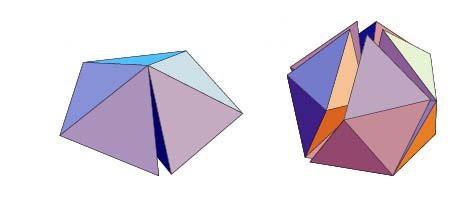Geometrical frustration (nonfiction): Difference between revisions
No edit summary |
|||
| Line 1: | Line 1: | ||
In condensed matter physics, the term '''geometrical frustration''' (or simply '''frustration''') refers to a phenomenon, where atoms tend to stick to non-trivial positions or where, on a regular crystal lattice, conflicting inter-atomic forces (each one favoring rather simple, but different structures) lead to quite complex structures. | [[File:Geometrical_frustration_icosahedron.jpg|Geometrical frustration of an icosahedron.]]In condensed matter physics, the term '''geometrical frustration''' (or simply '''frustration''') refers to a phenomenon, where atoms tend to stick to non-trivial positions or where, on a regular crystal lattice, conflicting inter-atomic forces (each one favoring rather simple, but different structures) lead to quite complex structures. | ||
== Description == | == Description == | ||
| Line 11: | Line 11: | ||
Frustrated magnetic systems had been studied earlier, including G. H. Wannier's study of the Ising model on a triangular lattice with nearest-neighbor spins coupled antiferromagnetically (published 1950). | Frustrated magnetic systems had been studied earlier, including G. H. Wannier's study of the Ising model on a triangular lattice with nearest-neighbor spins coupled antiferromagnetically (published 1950). | ||
== | == Fiction cross-reference == | ||
<gallery mode="traditional"> | |||
File:Klein bottles nesting.jpg|link=Klein bottle (nonfiction)|Nest of empty [[Klein bottle (nonfiction)|Klein bottles]] after an [[Extract of Radium]] lucubration. | |||
File:David_Hedison_releasing_neurotransmitters.jpg|link=Voyage to the Bottom of the Sea (TV series) (nonfiction)|[[Geometrical frustration (nonficition)|Geometrical frustration]] of no use to [[Voyage to the Bottom of the Sea (TV series) (nonfiction)|David Hedison]]. | |||
</gallery> | |||
* [[Dysprosium Titanate]] - an [[Transdimensional corporation|independent kingdom]] of [[Titan (nonfiction)|Titans (nonfiction)]] | * [[Dysprosium Titanate]] - an [[Transdimensional corporation|independent kingdom]] of [[Titan (nonfiction)|Titans (nonfiction)]] | ||
| Line 23: | Line 22: | ||
** Amassing a fortune in [[spin glass (nonfiction)]] gems and jewels | ** Amassing a fortune in [[spin glass (nonfiction)]] gems and jewels | ||
** Slipping and falling on [[spin ice (nonfiction)]] in a public and comical manner | ** Slipping and falling on [[spin ice (nonfiction)]] in a public and comical manner | ||
== Nonfiction cross-reference == | |||
* [[Dysprosium titanate (nonfiction)]] | |||
* [[Spin glass (nonfiction)]] | |||
* [[Spin ice (nonfiction)]] | |||
== External links == | == External links == | ||
Revision as of 16:45, 10 June 2016
 In condensed matter physics, the term geometrical frustration (or simply frustration) refers to a phenomenon, where atoms tend to stick to non-trivial positions or where, on a regular crystal lattice, conflicting inter-atomic forces (each one favoring rather simple, but different structures) lead to quite complex structures.
In condensed matter physics, the term geometrical frustration (or simply frustration) refers to a phenomenon, where atoms tend to stick to non-trivial positions or where, on a regular crystal lattice, conflicting inter-atomic forces (each one favoring rather simple, but different structures) lead to quite complex structures.
Description
As a consequence of the frustration in the geometry or in the forces, a plenitude of distinct ground states may result at zero temperature, and usual thermal ordering may be suppressed at higher temperatures.
Much studied examples are amorphous materials, glasses, or dilute magnets.
The term frustration, in the context of magnetic systems, has been introduced by Gerard Toulouse (1977).
Frustrated magnetic systems had been studied earlier, including G. H. Wannier's study of the Ising model on a triangular lattice with nearest-neighbor spins coupled antiferromagnetically (published 1950).
Fiction cross-reference
Nest of empty Klein bottles after an Extract of Radium lucubration.
Geometrical frustration of no use to David Hedison.
- Dysprosium Titanate - an independent kingdom of Titans (nonfiction)
- Gnotilus - supervillain known for:
- Amassing a fortune in spin glass (nonfiction) gems and jewels
- Slipping and falling on spin ice (nonfiction) in a public and comical manner
Nonfiction cross-reference
External links
- Geometrical frustration wiki.karljones.com
- Geometrical frustration @ Wikipedia

